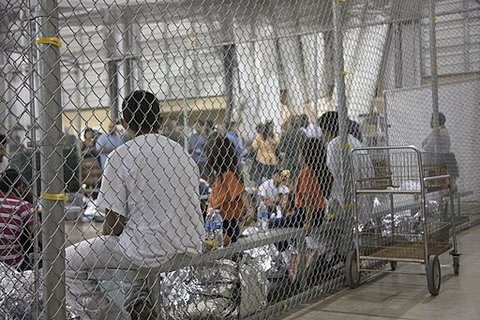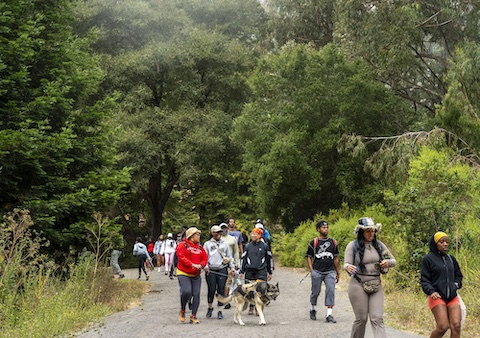
07 Oct ‘The Trauma Is the Point’: System Abuses Immigrants, Leads to Record Detentions, Increased Deaths

McAllen, Texas, detention facility on June 17, 2018. US Government, Public domain, via Wikimedia Commons
By Denis Perez-Bravo
The current immigration detention system was described as deliberately cruel and deadly during an Oct. 3 online national briefing, as immigration experts and advocates warned that conditions inside detention centers are meant to traumatize people seeking safety.
“We know that cruelty is the point,” former asylum officer Heather Hogan said. “Separating people from their families, taking them away from their communities — the trauma is the point to get people to leave the United States.”
Her comments came as journalists and advocates gathered for a weekly national briefing hosted by American Community Media.
Ten immigrants died in detention “between January and June, making that period the deadliest in recent history,” said journalist Pilar Marrero, who moderated the discussion. “More than 1,200 people are allegedly missing from the infamous and controversial Everglades facility dubbed Alligator Alcatraz, with families and attorneys unable to locate them.”
Nationally, she said there are close to 60,000 detainees, a record number driven by the criminalization of immigrants under the Trump administration.
“The rapid expansion of arrests and detention, combined with diminishing transparency,” she said, “signals a worsening situation for immigrants, many of whom have not been convicted of any crime.”
Death Count Is Unknown
Former attorney and now journalist Andrew Free, founder of the #DetentionKills project, said the suffering that immigrants are experiencing this year is unprecedented.
“This is a deadly time,” Free said.
The exact number of deaths varies across different sources because of reporting delays. The Detainee Death Reporting page on the Immigration and Customs Enforcement website lists 16 deaths in the fiscal year that ended Sept. 30, though the agency itself has reported other deaths since. The news site NOTUS reported Monday that 21 people died in immigration detention during that same period, citing publicly available data.
Free said the death total is “the second-highest level ever on record. Most of them happened in Florida, “mostly at Krome. That was a particularly overcrowded and understaffed area, and we had women sleeping in buses in the parking lot.”
Krome North Service Processing Center in Miami, according to AP News, has “a long history of abuse.”
Free said the number of detention facilities has quietly expanded.
He said new data from the Vera Institute revealed that ICE operates more than 460 detention sites; its website lists 124 detention facilities.
There is a hidden network of additional facilities he described as “black sites.”
“The nature of these sites is particularly troubling,” he said. “When you’re not in a detention statistical reporting system, you’re probably also not in the ICE detainee locator.”
And that, he said, is a “consequence of enforced disappearances,” he said, referring to the current system that allows agents to apprehend, detain and move someone without documenting the arrest.
It may not just be arrests that are not being documented.
“What I fear is there are people who are dying in state or local custody whose deaths are never being reported publicly,” Free said, “and they’re never being investigated and recorded.”
That would mean there’s no way of even knowing how many people have died in detention.
“What is the true number of people dying in ICE custody?” he asked. “I don’t actually know. And I don’t think anybody does.”
‘The System Is Extremely Dehumanizing’
Hogan, now policy and practice counsel with the American Immigration Lawyers Association, has helped asylum seekers in detention centers across Arizona, California and Texas.
“The contract security guards and ICE officers refer to immigration detainees as ‘bodies,’” Hogan said. “So the system is extremely dehumanizing, and mocking detainees and referring to them as bodies are common examples.”
She said asylum seekers, many without criminal records, are treated like prisoners, being bussed from prisons and forced to shuffle in orange jumpsuits, wrists and ankles shackled.
They are woken before dawn, left exhausted and hungry before facing crucial, life-changing interviews.
One by one, they are brought in from a holding cell where they had waited, some all day, to be interviewed.
Hogan said she remembers one man who needed to use the restroom but couldn’t find it and was subjected to a barrage of laughter, mocking and teasing from the guards.
“And then when the man turned around, the guard pretended like he was kicking him in the seat of his pants and then laughed about it with the other security guards,” Hogan said.
She said those struggling with mental health are often punished rather than helped. “Those contemplating suicide, or people who attempt to, they’re often put in solitary confinement,” she said. “Like transgender applicants, for example, HIV-positive individuals, they were also placed in solitary confinement.”
She said officials claim solitary confinement is for detainees’ protection, but the United Nations considers it a form of torture when it continues beyond a certain length of time.
Oversight Blocked Despite Reports of Neglect
Yannick Gill, senior counsel for refugee advocacy at Human Rights First, said that its reports document medical neglect, physical and psychological abuse, lack of legal representation, extended detention, and hazardous, unsanitary conditions.
He said that medical neglect can include basic failures such as withholding routine primary care, treatment for asthma attacks, or maternal care; improper treatment can result in preventable deaths.
Gill noted that as these reports are being released, efforts to provide oversight are simultaneously being obstructed as officials have been stopped from entering detention centers and even arrested.
“Blocking a sitting member of Congress is not just in violation of the Constitution — it should feel wrong,” Gill said. “It should make all of us stop and think, ‘What exactly is ICE hiding behind those walls?’”
Gill said his organization and two members of Congress were denied entry to Pennsylvania’s Moshannon Valley Detention Center after the August death of 32-year-old Chinese national Chaofeg Ge.
“We followed all of the requisite laws, two and a half weeks before we arrived,” he said. “The Constitution guarantees members of Congress to conduct oversight, and all of us were denied.”
For Hogan, the pattern of secrecy, neglect and despair is no accident.
She said that the government is deliberately making detention harsh and punitive, creating conditions so unbearable that people may choose to self-deport instead of seeking legal relief.
Detainees are frequently transferred between facilities, often to regions where they have no connections or support.
“One attorney reported on a client who decided to give up on her habeas petition because she mentally was breaking down,” Hogan said. “The cruelty is the point — and that should trouble all of us.”





No Comments